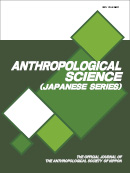Volume 116, Issue 2
Displaying 1-19 of 19 articles from this issue
- |<
- <
- 1
- >
- >|
Review
-
2008Volume 116Issue 2 Pages 99-113
Published: 2008
Released on J-STAGE: December 27, 2008
Download PDF (885K)
Original Articles
-
2008Volume 116Issue 2 Pages 115-129
Published: 2008
Released on J-STAGE: December 27, 2008
Download PDF (1104K) -
2008Volume 116Issue 2 Pages 131-143
Published: 2008
Released on J-STAGE: December 27, 2008
Download PDF (579K)
Special Topics
-
2008Volume 116Issue 2 Pages 145-148
Published: 2008
Released on J-STAGE: December 27, 2008
Download PDF (628K) -
2008Volume 116Issue 2 Pages 149-153
Published: 2008
Released on J-STAGE: December 27, 2008
Download PDF (392K) -
2008Volume 116Issue 2 Pages 154-160
Published: 2008
Released on J-STAGE: December 27, 2008
Download PDF (512K) -
2008Volume 116Issue 2 Pages 161-170
Published: 2008
Released on J-STAGE: December 27, 2008
Download PDF (759K) -
2008Volume 116Issue 2 Pages 171-175
Published: 2008
Released on J-STAGE: December 27, 2008
Download PDF (403K) -
2008Volume 116Issue 2 Pages 176-181
Published: 2008
Released on J-STAGE: December 27, 2008
Download PDF (460K)
Symposium
-
2008Volume 116Issue 2 Pages 183-184
Published: 2008
Released on J-STAGE: December 27, 2008
Download PDF (496K) -
2008Volume 116Issue 2 Pages 184-187
Published: 2008
Released on J-STAGE: December 27, 2008
Download PDF (770K) -
2008Volume 116Issue 2 Pages 187-190
Published: 2008
Released on J-STAGE: December 27, 2008
Download PDF (908K) -
2008Volume 116Issue 2 Pages 191-194
Published: 2008
Released on J-STAGE: December 27, 2008
Download PDF (703K) -
2008Volume 116Issue 2 Pages 194-198
Published: 2008
Released on J-STAGE: December 27, 2008
Download PDF (864K) -
2008Volume 116Issue 2 Pages 199-202
Published: 2008
Released on J-STAGE: December 27, 2008
Download PDF (787K) -
2008Volume 116Issue 2 Pages 202-206
Published: 2008
Released on J-STAGE: December 27, 2008
Download PDF (765K) -
2008Volume 116Issue 2 Pages 207-210
Published: 2008
Released on J-STAGE: December 27, 2008
Download PDF (1083K)
Erratum
-
2008Volume 116Issue 2 Pages 211-218
Published: 2008
Released on J-STAGE: December 27, 2008
Download PDF (509K)
Front Line
-
2008Volume 116Issue 2 Pages 219-223
Published: 2008
Released on J-STAGE: December 27, 2008
Download PDF (990K)
- |<
- <
- 1
- >
- >|
